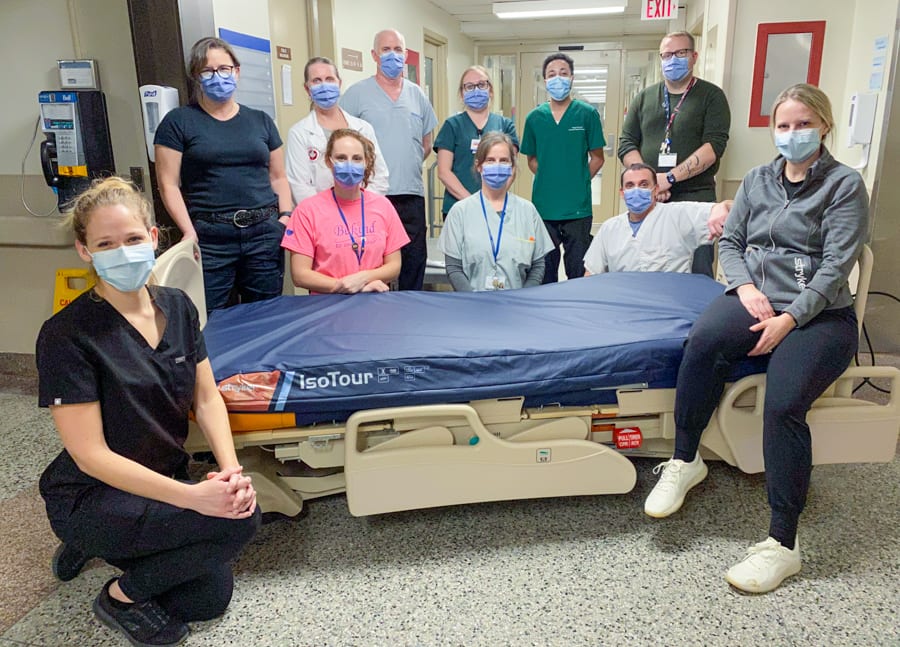
From left: Christie Shewchuk from Stryker, Niagara Health Injury Prevention Consultant, Debbie Fenwick, Advance Practice Nurse Lee Bateman, Injury Prevention Consultant Tavia Bond, Environmental Services Aide Don MacNeil, Personal Support Worker Anna Kus, Manager of Clinical Services Tanja Groeneveld, Personal Support Worker Elijah Gardner, Environmental Services Aide Jeff Moran, Environmental Services Manager Adam Tuttle, and Kerri Quattro from Stryker are part of the team changing over mattresses and stretcher surfaces at all five Niagara Health sites.
It wasn’t long after receiving a new gel mattress at Niagara Health’s Port Colborne Site earlier this month that a patient commented that she was a lot more comfortable.
The mattress moved when she did, redistributing pressure by buckling and absorbing her weight. That’s something the foam surface she’d been recuperating on before didn’t do.
Other patients will soon have a similar experience as Niagara Health swaps hundreds of foam mattresses for gel versions in the coming weeks in a benchmark effort to prevent pressure injuries and improve patient care.
“The impact this will have on patients is significant,” says Tanja Groeneveld, Clinical Manager, Professional Practice. “It’s all about providing extraordinary care, and this is an effective and innovative way to do it.”
Wounds Canada reports about 26 per cent of Canadian hospital patients experience pressure injuries, also known as pressure ulcers or bed sores. They happen when skin breaks down from pressure, friction, or moisture that builds up when a patient lies in bed for extended periods without moving.
Hospital-acquired pressure injuries can occur after just a few hours and are most common on the sacrum, tailbone and heel. They can prolong and complicate a patient’s healthcare journey but the good news is that many are preventable.
Niagara Health’s massive upgrade, which started at the Fort Erie Site in December, will see 451 foam mattresses and 350 foam stretcher surfaces replaced with gel across all five sites. The changeover is a multi-team project, involving collaboration with Environmental Services, Strategic Sourcing, the Staffing Resource and Wound Ostomy Continence teams, Occupational Health, and the mattress vendor, Stryker.
The teams started with the smaller sites to fine-tune the process of swapping mattresses, focusing their efforts on limiting patient disruption and preventing repetitive strain injury on those doing the heavy lifting.
The foam mattresses being replaced will be donated to Niagara Warehouse of Hope, a non-profit that will distribute them to communities in need in Cuba, the Philippines and Ukraine.
The upgrade is part of Niagara Health’s Pressure Injury Prevention Strategy, which is rooted in patient safety and extraordinary care. Once the switch is complete, Niagara Health will be a leader in pressure injury prevention, explains Lee Bateman, an advanced practice nurse with the Wound Ostomy Continence Team. Bateman advocated for the changeover in collaboration with the Professional Practice Team.
The new mattresses also benefit healthcare staff, Lee notes. More than 100 mattresses have a feature that helps position patients so nursing staff can turn them more easily, reducing friction and risk of injury.
Doing the swap will also save Niagara Health about $300,000 a year in equipment rental costs.
Plans are to complete the upgrade at all sites by the end of March with the Niagara Falls Site next on the to-do list.

